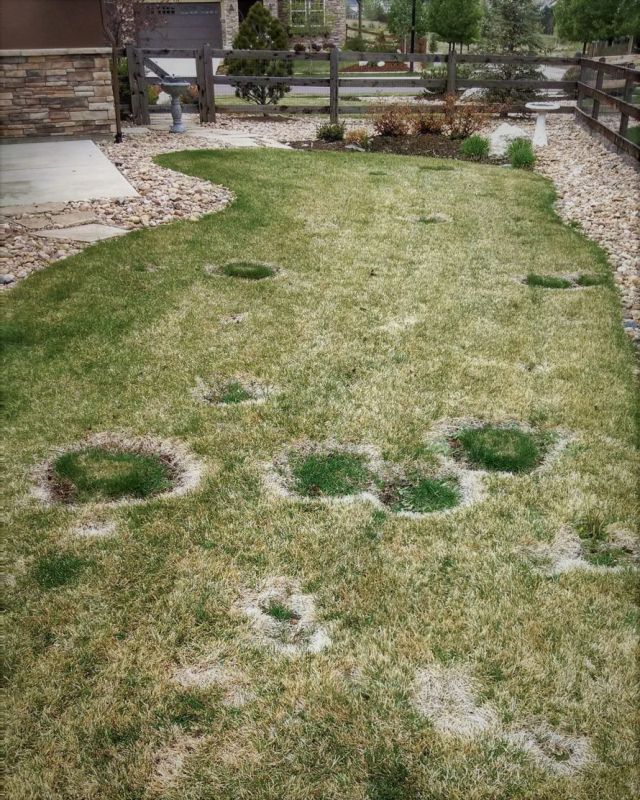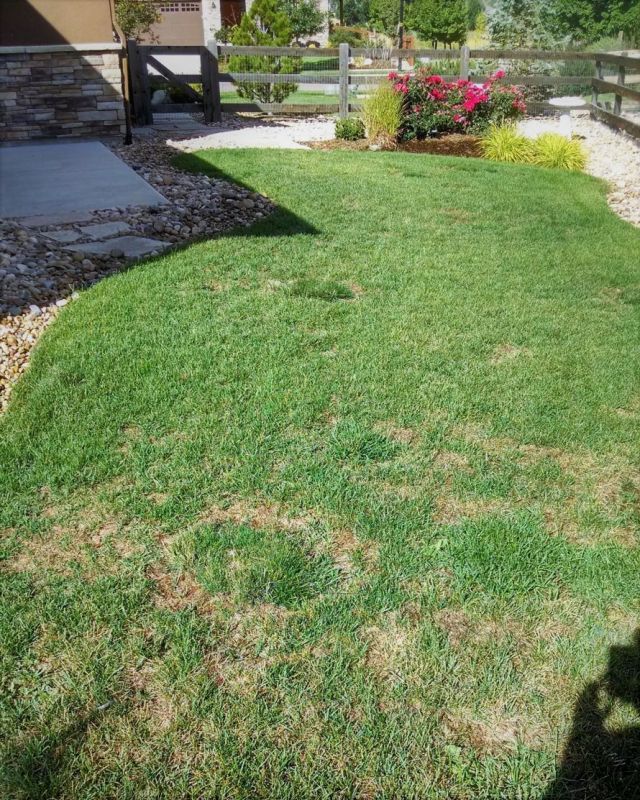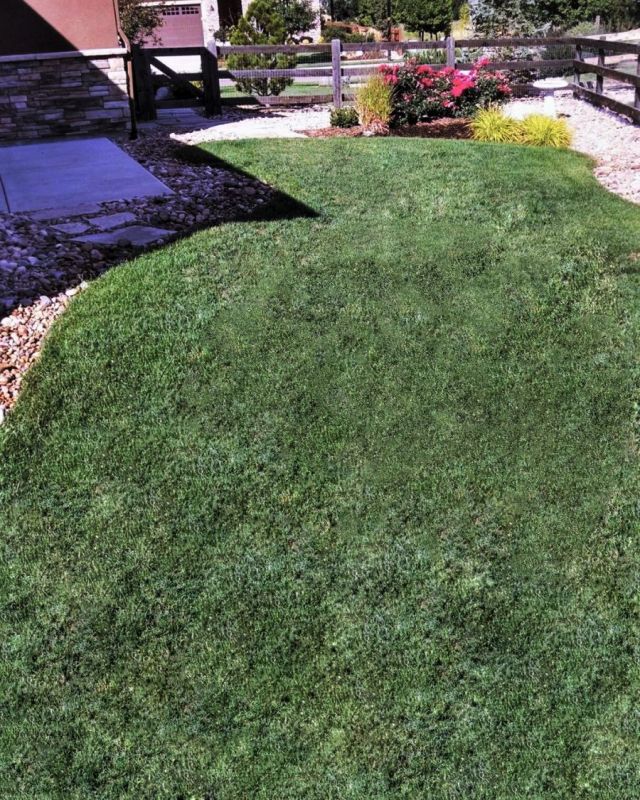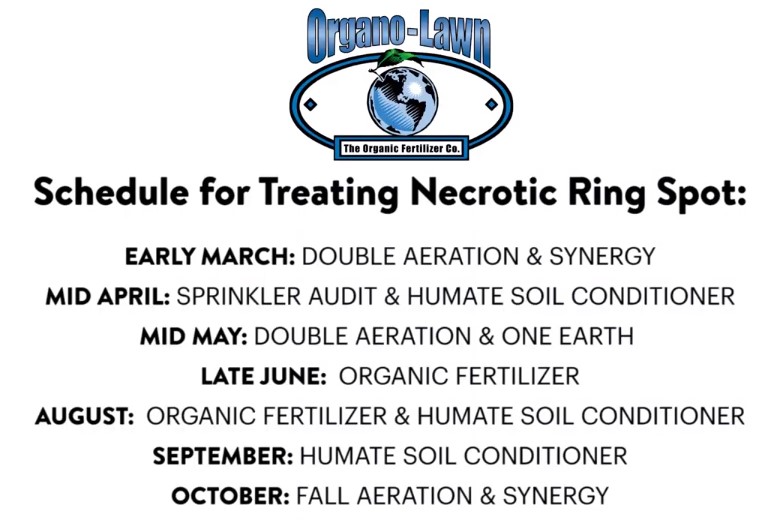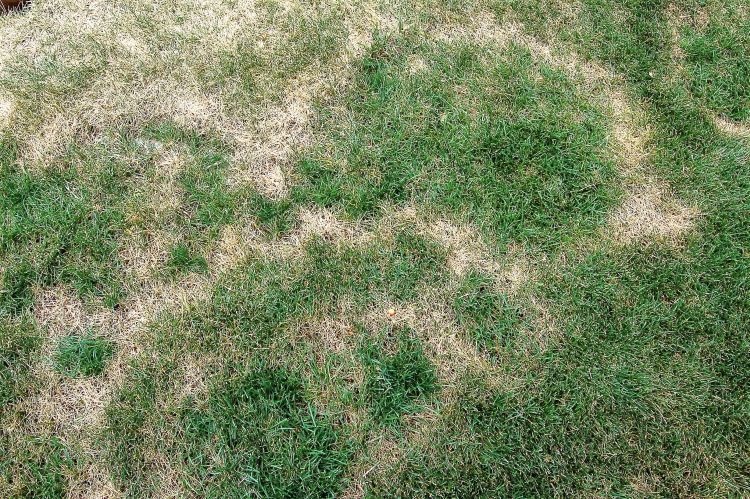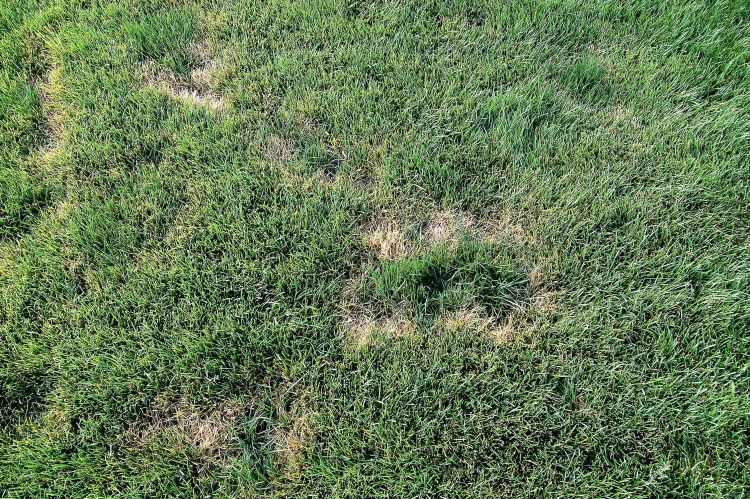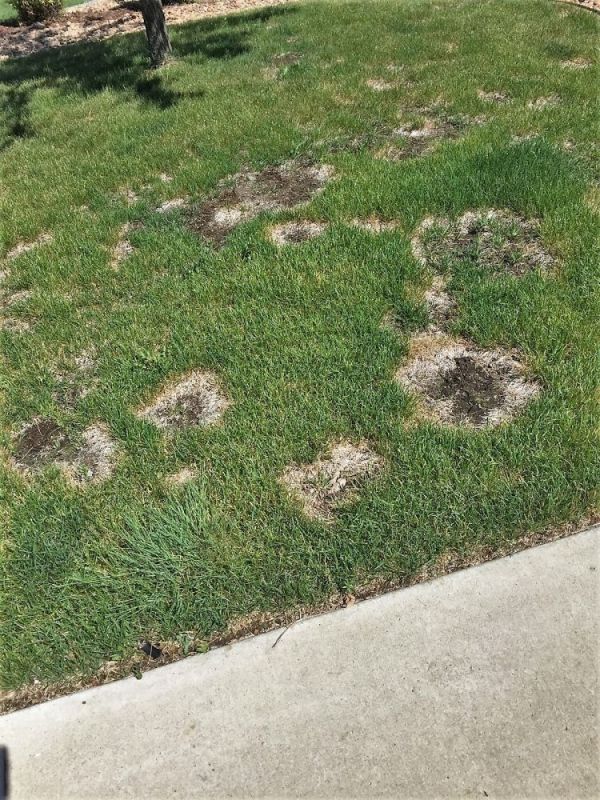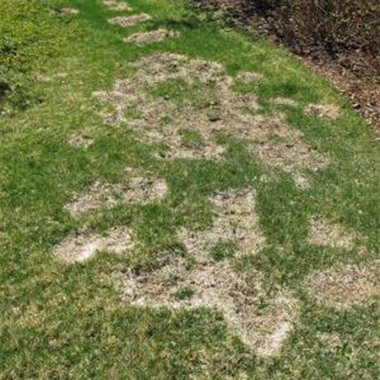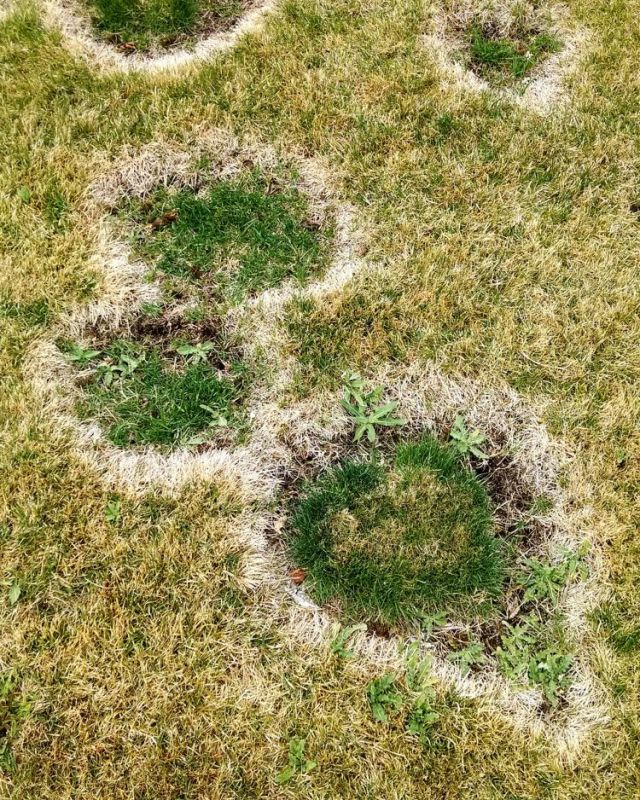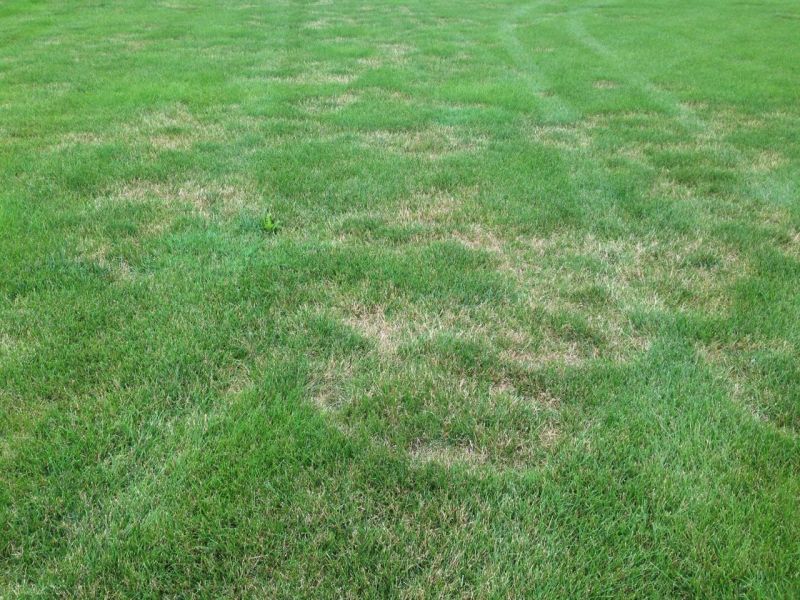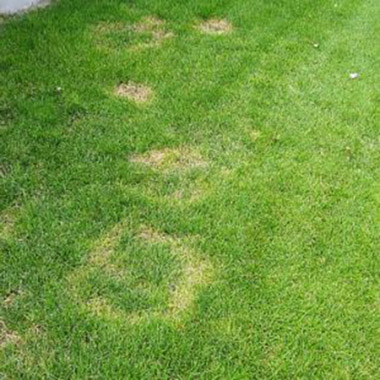NECROTIC RING SPOT TREATMENT
How to Control Necrotic Ring Spot without Chemicals
Fusarium Blight, more commonly known as Necrotic Ring Spot, is a soil borne lawn fungus, which is identified by circular to irregular sunken straw colored or gray patches approximately 4-16 inches in diameter. Necrotic ring spot fungus is caused by severe over watering of a lawn for a long period of time and is cured by stopping these poor cultural practices caused by humans.
Necrotic ring spot (NRS) in lawns is a symptom of a problem and if we stop the cause of the problem, we should expect the symptoms to go away. Therefore, the first step in fixing the Necrotic Ring Spot problem is to stop the severe over watering of the lawn.
Necrotic ring spot is a common lawn fungus worldwide, but it is most common in states like Colorado where the majority of lawns have sprinkler systems. Mother nature typically does not over water a lawn for months on end; however, irrigation system can over water a lawn for many consecutive months.
Over watering is the cause of necrotic ring spot fungus in lawns for two reasons. First, over watering stimulates the Necrotic Ring Spot fungus spores and secondly over watering the lawn kills the beneficial microbial activity in the soil, causing a problem we call “dead soils”.
Dead soils lack beneficial microbes, which stabilize the soil’s microbiome, and the absence of beneficial microbes means the necrotic ring spot fungi can live without competition from other microorganisms. Without the beneficial microbes to compete with the Necrotic Ring Spot fungus, plus the over saturation of soils which stimulate the fungus spores, the necrotic ring spot fungus can spread through a lawn quickly.
When a necrotic ring spot lawn fungus outbreak does occur, the fungus in lawns can be difficult to control and will take about 9 months or longer to cure. The reason for the extended length of time for treatment is because it takes 6 months to 1 year to rebuild the soil. Until the microbial activity in the soil is fully reestablished then the necrotic ring spot fungus will continue to be a problem. Patience is a very important aspect when a lawn is recovering form necrotic ring spot.
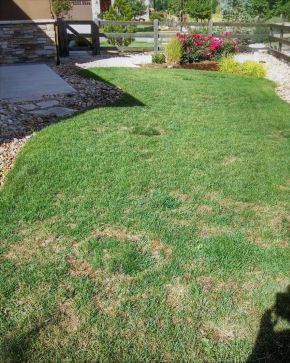
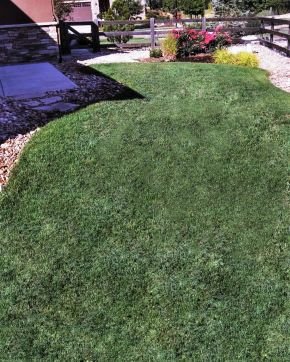
How to Cure Necrotic Ring Spot in Grass
Why you should never apply fungicides to a lawn with Necrotic Ring Spot Fungus
Always avoid using a fungicide when treating Necrotic Ring Spot in a lawn. The fungicide is designed to kill microbes and it will kill both the bad microorganisms and the beneficial microorganisms that are living in the soil. The long-term cure for necrotic ring spot is to stimulate a large population of diverse microorganisms in the soil. After the soil is reestablished and the soil is teaming with microbes, the beneficial microbes will kill the necrotic ring spot fungus spores.
The reason the beneficial microbes died in the first place was because too much water replaces air in the soil and without air the microbes die.
Important Note: The Necrotic Ring Spot fungus spores are present in all soils and are not spread via core aeration, lawn mowing or other lawn equipment. The fungus spores are everywhere; the only time they become a problem is when they are stimulated by severe over watering for a long period of time.
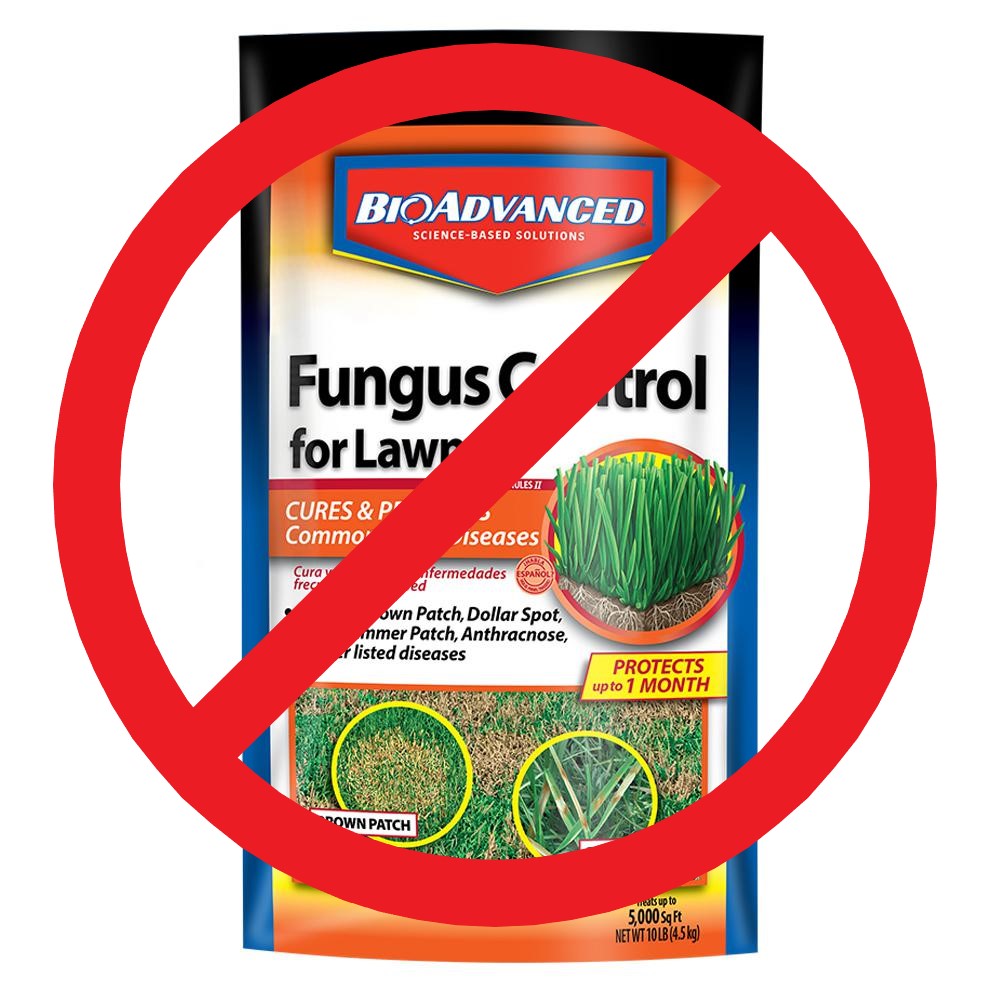
How to Cure Necrotic Ring Spot Fungus
Build a Living Soil
Step 1: Fix the Lawn Watering
- The most important thing to do is to fix the improper over watering of the lawn. Necrotic Ring Spot is only found in severely moist or wet areas with poor drainage. Make sure to follow the 1-2-3-2-1 lawn watering technique. This lawn watering technique allows enough time between lawn watering so the soil has time to completely dry out. Also, it is important to water early in the morning as opposed to late at night. If the over watering is not corrected then the lawn fungus problem will never recover! Organo-Lawn will not guarantee curative results for your Boulder or Fort Collins area lawn unless you have a sprinkler startup / audit performed by an Organo-Lawn employee.
- It is very important to completely rebuild the beneficial microbial populations in the soil. The fungus will continue to be a problem until the beneficial microbial activity is restored. Rebuilding the soil takes time. A severe case of necrotic ring spot can take 1-2 years to fully recover.
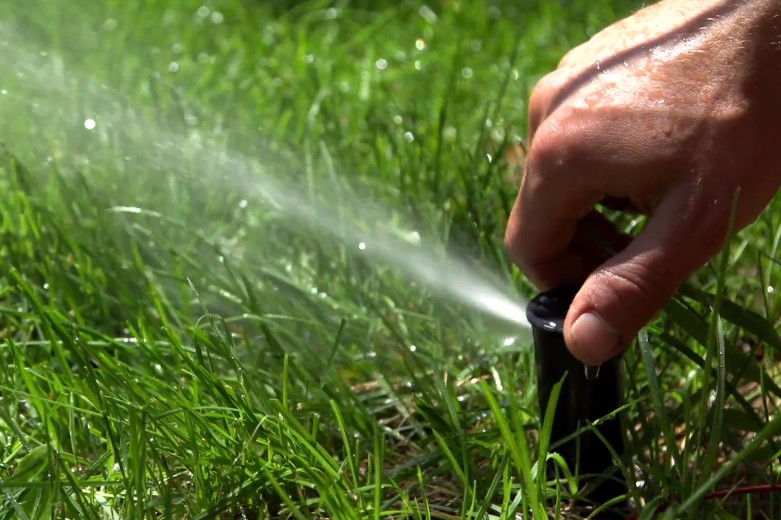
Step 2: Core Aeration
- Perform 2-3 lawn aerations, one in early spring, one in late spring, and one in the fall to alleviate soil compaction and introduce air into the soil so the microbes can breathe. Air is vital to establishing a living soil and the more a lawn is aerated the faster the lawn will recover.
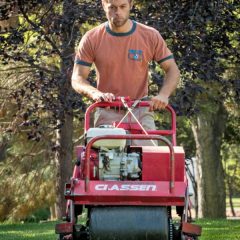
Step 3: Remove the Dead Grass
- Manually remove the dead grass in the necrotic ring spot circles. You can do this using a heavy metal rake.
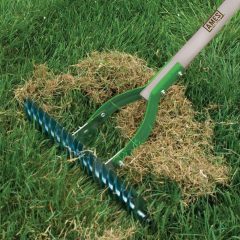
Step 4: Apply Humate Soil Conditioner
- Stimulate beneficial microbial activity by applying Humate soil conditioner 2-3 times per year. Humate will stimulate beneficial microbial activity and help break up compacted soils.
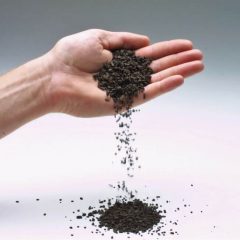
Step 5: Only Apply High Quality Organic Fertilizers
- Never fertilize the lawn with fast release or inorganic nitrogen sources. Fast release nitrogen is typically white in color and high in salt. These non-organic nitrogen sources kill beneficial microorganisms and will slow the recover process.
- Change all fertilization to organic fertilizers. Chemical fertilizers are high in salts and kill microbes. A very good organic fertilizer for curing necrotic ring spot is Synergy with Corn Gluten Meal.
- Never apply synthetic chemical herbicides (weed control) or chemical fungicides to the area. Chemical herbicides and fungicides can hinder or even kill essential beneficial microbial activity.
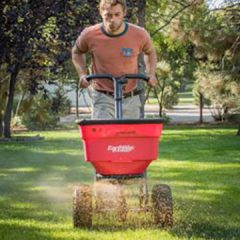
Step 6: Proper Lawn Mowing
- Never mow the grass when it is wet, and always wait 24 hours after a mowing to water the grass. After a mowing the grass blades have been damaged. It takes 24 hours for a grass to repair the abrasion. If water is added to the lawn before the lesion has time to heal, the fungus can use the water as a transportation mechanism and infect new and otherwise healthy blades of grass. Make sure to mow the grass at 3 inches or taller.
- Until the necrotic ring spot fungus is eliminated, bag the grass in the infected area, increase the mowing height to 3” or 3.5”, and increase the mowing frequency so no more than 1/3 of the blade of grass is removed per mowing.
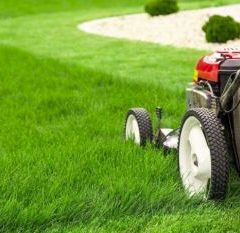
Step 7: Be Patient
- Patience is the most difficult part for most homeowners. If the lawn does not respond to steps 1-9 and it has been 1 year since treatment began on the disease it is because the soil is still dead or lacking beneficial microbial activity. Microbes are just like everything else they need air, heat, water (moist but not suffocated with too much water), and food (organic fertilizers). If the lawn has not recovered it is because one of the following is still not being achieved: Air, water, heat, and food. Remember too much water replaces air in the soil and if the lawn is being over watered the microbes cannot breathe.
- Notice that we DO NOT recommend the use of a fungicide. The reason for this is that fungicides kill beneficial microbes and we are trying to rebuild the beneficial microbial activity in the soil. We have found that the lawn will recover much faster if a fungicide is NOT applied because the fungicide can kill beneficial microbes for up to 3 months after the initial application. DO NOT APPLY A FUNGICIDE AS IT IS COUNTER PRODUCTIVE.
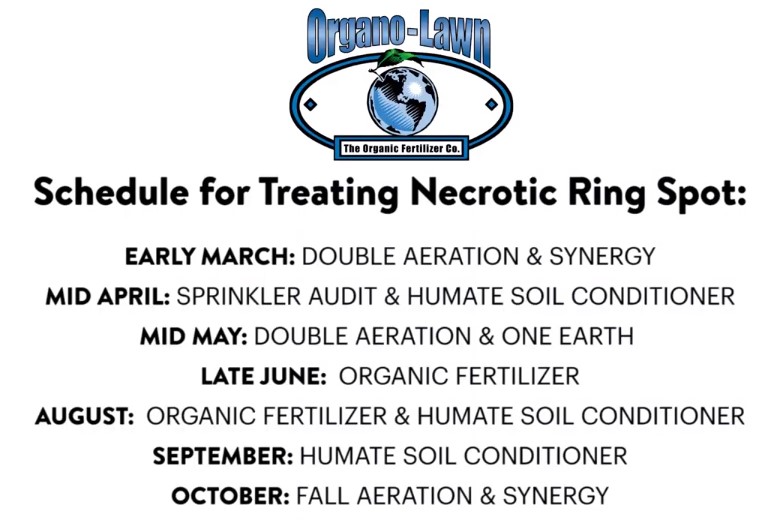
Step 7: If You Aren’t the Patient Type!
- We offer compost spreading that will speed up recovery by up to 50%.
- We still DO NOT recommend the use of a fungicide. The reason for this is that fungicides kill beneficial microbes and we are trying to rebuild the beneficial microbial activity in the soil. We have found that the lawn will recover much faster if a fungicide is NOT applied because the fungicide can kill beneficial microbes for up to 3 months after the initial application. DO NOT APPLY A FUNGICIDE AS IT IS COUNTER PRODUCTIVE.
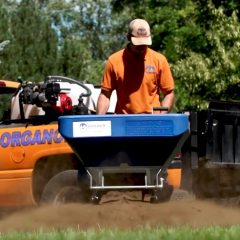
Professional Lawn Care Companies
Treatment of necrotic ring spot fungus seems simple; however getting the watering corrected can be complicated. Our recommendation is to contact Organo-Lawn in Boulder (303) 499-2000 or Fort Collins (970) 225-9425 and schedule a disease diagnosis with one of our professional lawn care technicians. Our state licensed lawn care technician will come up with a plan to correct the problems that are causing this fungus.
Photos of Necrotic Ring Spot Fungus – (Click on Images to Enlarge)
FAQ – NRS Lawn Fungus Treatment
How to fix a Necrotic Ring Spot lawn?
To cure Necrotic Ring Spot we must stop what is causing the problem and not just treat the symptoms. Necrotic Ring Spot Fungus infestations in a lawn indicate that the lawn has been severely over watered for many months. Typically the most damaging lawn fungus problems like Necrotic Ring Spot are caused by severe over watering of a lawn. Water replaces air in the soil which creates an anaerobic environment where only certain types of soil microbes can survive. The most important step in curing the fungus problem is watering deeply and infrequently according to the 1-2-3-2-1 lawn watering technique.
The key to curing a Necrotic Ring Spot Lawn fungus problem is to create a living soil that is teeming with microbial activity. The more diverse and competitive the microbial population is in the soil the healthier the lawn will be. Important lawn care services to help cure Necrotic Ring Spot fungus without chemicals include Humate soil conditioner, lawn aeration, and proper lawn mowing. Never apply a lawn fungicide to a lawn that is infested with Necrotic Ring Spot because fungicides will kill both the damaging microbes and the beneficial microbes in the soil and this is the opposite approach to curing the lawn fungus problem.
